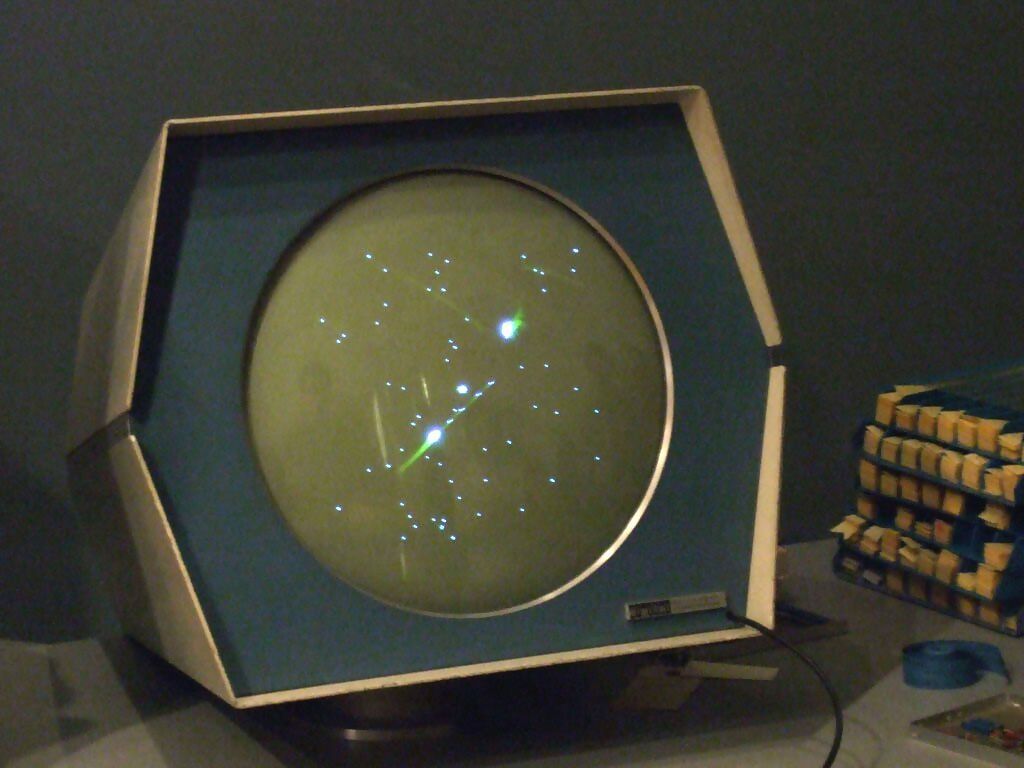
Without Spacewar!, odds are games today would look very different. Mr Biffo charts the history of one of gaming’s most celebrated genres.
What is it with video games and space? Pretty much from the start, science fiction – specifically science fiction featuring aliens and spaceships – had a massive influence on the games people created. Spacewar! – their exclamation, not mine (although I am similarly excited) – was the first bona fide digital video game, and right out of the gate it wrapped its thighs around a sci-fi theme.
It was created in 1961 on a PDP-1 minicomputer by massive nerd Steve Russell and his equally nerdy friends Martin Gaetz and Wayne Wiitanen (who would later lend part of his name to a Nintendo console, possibly). A two-player, vector graphics space battle that played out against a star field, it even featured simulated physics – the dogfights took place in the gravity well of a star.

Long before Star Wars, or Alien, game developers were already flaunting their love of sci-fi
Wearing their nerd credentials on their space sleeves, Spacewar!’s creators apparently took direct inspiration from the Lensman series – a long-forgotten series of science-fiction novels. If, like me, you’d never heard of the Lensman series, you would, like me, benefit from reading the official blurb:
“No human being had ever landed on the hidden planet of Arisia. A mysterious barrier, hanging unseen in space, turned back all ships. Then the word came to Earth, inexplicably but compellingly: go to Arisia!
“Virgil Samms, founder of the Galactic Patrol, went – and came back with the Lens, the strange device that gave its wearer powers no man had ever possessed before. Samms knew that the price of this power would be high. But even he had no idea of the ultimate cost – nor of the strange destiny that awaited the First Lensman…”
Now… what I know of Spacewar! suggests that some of the series’ nuance was lost in its translation into the first proper computer game, and that Russell and co may not have known their Arisia from their elbows. Still, the fact remains that long before Star Wars, or Alien, or Blade Runner, game developers were already flaunting their love of sci-fi pop culture.
SPACEWAR! SELLS OUT!
As influenced by sci-fi as it was, Spacewar! itself became influential and formed the basis of the first commercial video game. To wit: Ted Dabney and Nolan Bushnell’s Computer Space. Whereas Spacewar! could only be played by two players – there wasn’t enough memory for a computer-controlled opponent – Computer Space was launched in 1971 as a single-player game, before getting a multiplayer version two years later.
It was only a moderate success – perhaps not entirely surprising given there had been nothing like it before – but is perhaps best remembered for its retro-futuristic cabinet design. That iconic cabinet was so stylish it even featured in the 1973 dystopian movie Soylent Green (spoiler: it is people). However, Computer Space arrived roughly a year or two too late to fully capitalise on the spacemania that was kicked off by the Apollo moon missions, the release of 2001: A Space Odyssey, and NASA’s bold plan to blow up the sun.

Fun fact: Space Invaders’ working title was believed to have been… Space Monsters
Nevertheless – starting as it intended to continue – it took less than a year for the embryonic games industry to produce its first Computer Space clone, in the form of the not-exactly-officially licensed Star Trek, produced by For-Play (stop chortling at the back).
The reasons why Computer Space failed as a commercial proposition might’ve been due to the lack of both arcades and a home computer scene. Most Computer Space units were sold to bars, and its gameplay – described by one former Atari employee as “horrible” – was too complicated for the average beered-up bar-goer.
It’s little wonder that they proved far more receptive to the comparatively simple Pong, released the following year.
GIVE ME SPACE!
Still, this wasn’t to be the end of games and space, as well you know. Another Spacewar!-inspired arcade game, Cinematronics’ we’re-not-even-going-to-pretend Space Wars, was released in 1977. Though mostly forgotten now, it was the biggest arcade game of both that year and the next, later getting a port for the Vectrex.
Of course, there was something bigger orbiting over the horizon.
Something much, much bigger.
Invasion!
In 1978, Taito released Space Invaders, and video games went from being a cult hit to a genuine phenomenon. Its creator Tomohiro Nishikado borrowed cues from H.G. Wells’ The War of the Worlds, the anime series Space Battleship Yamato, and – of course – the somewhat popular space fantasy movie Star Wars. You don’t need me to tell you that Space Invaders became arguably the most successful video game of all time, and helped to recement space and sci-fi as a commercially viable proposition after facing a decade or more of comprehensive shrugging.

Arcade cabinet advertising material also had a lot of fun with the industry’s ongoing space theme.
Space Invaders might’ve changed everything, but the influence of Spacewar! didn’t stop there. Dabney and Bushnell may not have released a commercially viable game based upon Spacewar!, though in 1979 their company Atari did.
Created by Ed Logg and Lyle Rains, Asteroids retained the vector graphics visuals, physics, and some of the gameplay of Computer Space, Spacewar!, and Space Wars, but married it all to gameplay that proved – for most people – more accessible than earlier attempts.
Asteroids may not have been a Space Invaders-sized phenomenon, but it remains one of the key releases of the golden age of arcade games. Without Spacewar! – created 18 years earlier – we would’ve had no Asteroids, and without Asteroids, there would’ve been no Defender, Gravitar, Battlezone, Tempest, Star Wars (the arcade game), or the Vectrex.
Such an influence isn’t bad going for a game that predated The Rolling Stones, the first working communications satellite, and the JFK assassination





